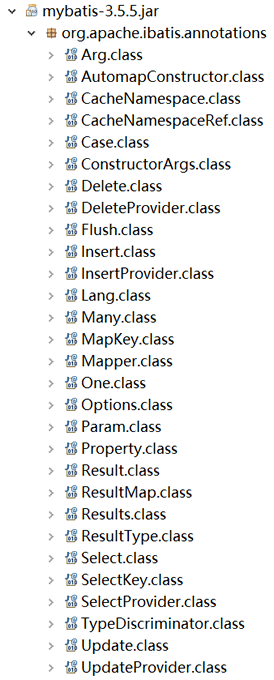
@Insert("insert into user(id,name) values(#{id},#{name})")
public int insert(User user);
@Select("Select * from user")
@Results({
@Result(id = true, column = "id", property = "id"),
@Result(column = "name", property = "name"),
@Result(column = "sex", property = "sex"),
@Result(column = "age", property = "age")
})
List<User> queryAllUser();
@Insert("insert into user(id,name) values(#{id},#{name})")
@SelectKey(statement = "select last_insert_id()", keyProperty = "id", keyColumn = "id", resultType = int,before = false)
public int insert(User user);
@SelectKey 各个属性含义如下。
@Insert("insert into user(name,sex,age) values(#{name},#{sex},#{age}")
int saveUser(User user);
@Update("update user set name= #{name},sex = #{sex},age =#{age} where id = #{id}")
void updateUserById(User user);
@Delete("delete from user where id =#{id}")
void deleteById(Integer id);
int saveUser(@Param(value="user") User user,@Param("name") String name,@Param("age") Int age);
@Param 中的 value 属性可省略,用于指定参数的别名。
@Select({"select id, name, class_id from student"})
@Results(id="studentMap", value={
@Result(column="id", property="id", jdbcType=JdbcType.INTEGER, id=true),
@Result(column="name", property="name", jdbcType=JdbcType.VARCHAR),
@Result(column="class_id ", property="classId", jdbcType=JdbcType.INTEGER)
})
List<Student> selectAll();
下面为 @Results 各个属性的含义。
@Select({"select id, name, class_id from student where id = #{id}"})
@ResultMap(value="studentMap")
Student selectById(Integer id);
这样不需要每次声明结果集映射时都复制冗余代码,简化开发,提高了代码的复用性。
@Select("select * from student")
@Results({
@Result(id=true,property="id",column="id"),
@Result(property="name",column="name"),
@Result(property="age",column="age"),
@Result(property="address",column="address_id",one=@One(select="net.biancheng.mapper.AddressMapper.getAddress"))
})
public List<Student> getAllStudents();
@Select("select * from t_class where id=#{id}")
@Results({
@Result(id=true,column="id",property="id"),
@Result(column="class_name",property="className"),
@Result(property="students", column="id", many=@Many(select="net.biancheng.mapper.StudentMapper.getStudentsByClassId"))
})
public Class getClass(int id);
本文链接:http://task.lmcjl.com/news/7200.html